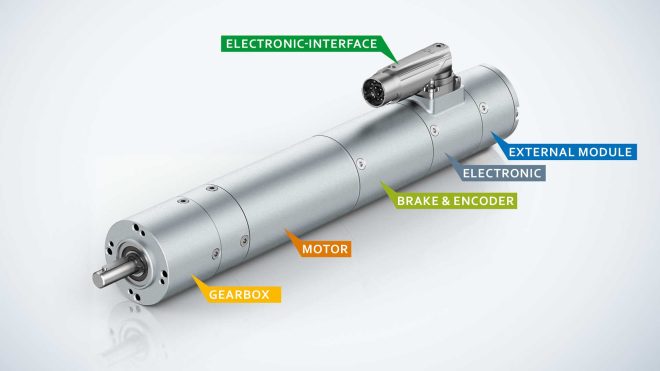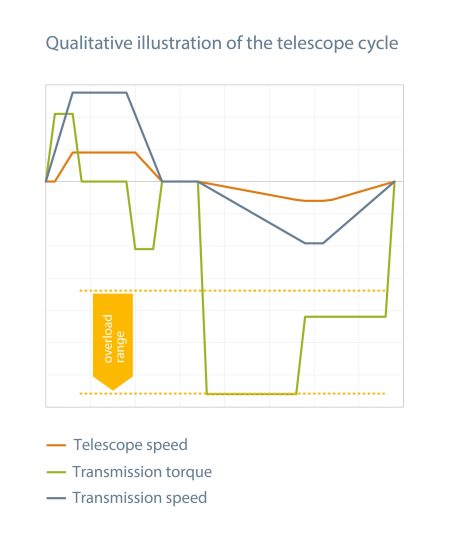The same applies to shuttle applications as to all intralogistics: the faster the vehicles can accelerate and brake, the higher the throughput rate and the more goods can be picked or supplied. Accuracy when driving up to the storage locations and handling the products or product carriers is also an important requirement for this, as is reliability, because if the hard-working vehicles fail, the warehouse processes come to a standstill.
Tough requirements for the drives
Drives that ensure that shuttles move in a targeted manner within the shelf systems play a key role here. For example, the one – or sometimes two – traction drives must be dynamic, accurate and robust for the movements in the direction of the x-axis and it must be easy to integrate them into the application. The latter not only applies to the drive’s dimensions, but also to its connection to the vehicle’s control system. The telescopic drives for the pick-up device that removes the goods from or adds them to the shelf is just as important for smooth shuttle operation.
Here, there is often even less installation space for the necessary motor-transmission combinations than there is for the traction drive. In some types of warehouse, shuttles do not only travel in one direction, they can also travel across the warehouse. This requires similar drive concepts to the traction drive, in some cases with much more compact dimensions.

Fig. 1: In the Modular drive system, all individually selected drive components are placed in a common housing. (Graphic | ebm-papst)
Manufacturers are well-advised to find a motor manufacturer that can give them skilled support in selecting a motor and that has a broad range. Drive solutions from a single source not only provide logistical benefits, they usually simplify coordination and shorten the time to market. That is why ebm-papst offers a wide selection of motors, control electronics, transmissions, and brake and sensor modules that can be combined to create a tailor-made drive (Fig. 1).
The electronically commutated ECI motors, for example, cover a continuous power range from 30 to 750 watts in sizes 42, 63 and 80 mm. Then, different transmissions matched to the drives ensure the necessary reduction ratio of the high-speed internal rotor motors. The transmissions can also be combined with the external rotor motors in the VDC series.
The latter cover a power range of 5 to 125 watts in the smallest installation space and also boast a long service life and good control properties. The modular drive system offers several thousand variants in total. Defined preferred types are ready for shipment within just 48 hours, making them available for sampling exceptionally quickly. In addition, the motor and transmission specialists offer project-specific engineering, e.g. when it comes to fine tuning the motors or special transmissons and when adaptations to the overall length, cable assembly or additional encoders are required.
Dynamic traction drives
The modular drive system enables standard solutions to be implemented for many applications. For example, the ECI internal rotor motors are ideal for use as shuttle traction drives, depending on the required power, either in size 63 or 80 (Fig. 2). They require little installation space, achieve high torques at 24 or 48 V, and are able to deliver three times the nominal power for a short time. Combined with the Optimax transmissions, which already have overload capacity, compact, robust drive systems are created, which can also be controlled based on the application through the motor electronics chosen.

Fig. 2: The ECI internal rotor motors, for example, are ideal for use as shuttle traction drives. (Graphic | ebm-papst)
The K1 electronics module is designed for operation with external control electronics. If the drives are to communicate via CANopen, EtherCAT or other common BUS systems, the K5 electronics module is the right choice. It can have an external or integrated design. Configurable, integrated control electronics for speed, torque and position are available for analog actuation.
The planetary gears in the Optimax series also have a high power density and are also very robust and durable. Another special feature of the transmission series is the high torques. The medium variant, for example, offers peak torques of up to 150 Nm with an installation edge dimension of 63 mm and a length of just 102 mm in the two-stage version.
Bespoke telescopic drive
In the shuttles, space for the telescopic drive is usually at a premium. This is a typical area of application for the VDC 49.15 external rotor motor (Fig. 3), for example.

Fig. 3: The VDC 49.15 external rotor motor is an ideal telescopic drive. With a power of 110 W, it is just 52 mm long with a diameter of 63 mm and can be easily combined with the robust Optimax planetary gear. (Graphic | ebm-papst)
With a power of 110 W, it is just 52 mm long with a diameter of 63 mm and can also be easily combined with the robust Optimax planetary gear. This compact design means that one drive can be used per telescopic arm, thus two drives per telescope, which massively increases the power density of the shuttle and the throughput rate of the warehouse. It is also possible to adapt the transmission design, with the appropriate number of units.

Fig. 4: The compact telescopic drive exhibits impressive results. (Graphic | ebm-papst)
The test stand proves what this type of telescopic drive can achieve. All shuttle drives can be tested before they are used and the profiles required for the application can be run off. If necessary, the values then form the basis for fine tuning, as the motors can often do far more than what it says on the data sheets. In any case, the telescopic drive described above delivers impressive results on the test stand (Fig. 4).
In combination with a two-stage Optimax planetary gear, a drive unit delivers a torque of 10.5 Nm to the output shaft. Therefore, the telescopic mechanism can move 50 kg cargo load with an acceleration of 1.1 m/s².
A drive solution like this is also recommended if the width of the gripper system has to be adjusted to adapt it to different product carriers. If there is no standard solution, the motor and transmission specialists can help with the selection and engineering.
In the field of drive technology, we offer a great deal of experience and know-how for a wide variety of requirements. In our drive technology special, we give you an insight into our diversity – read on!

Leave a comment